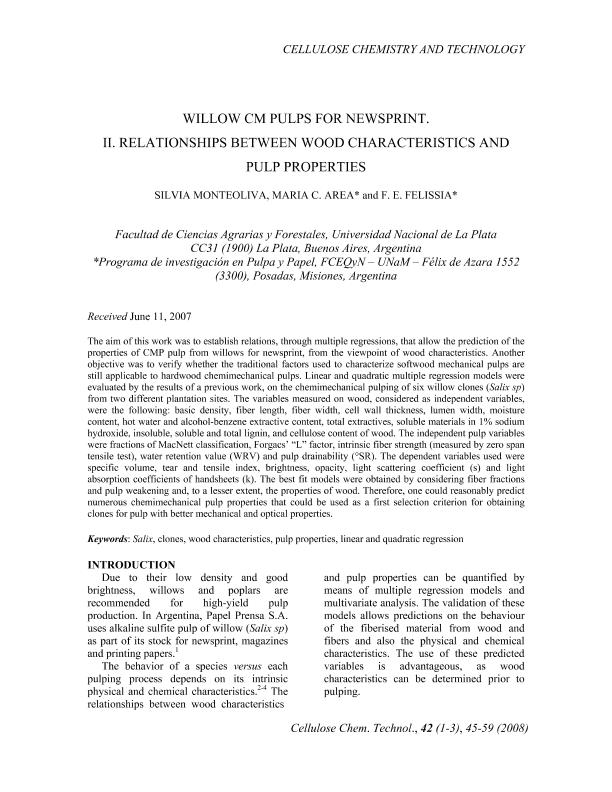Mostrar el registro sencillo del ítem
dc.contributor.author
Monteoliva, Silvia Estela

dc.contributor.author
Area, Maria Cristina

dc.contributor.author
Felissia, Fernando Esteban

dc.date.available
2018-10-18T14:10:27Z
dc.date.issued
2008-02
dc.identifier.citation
Monteoliva, Silvia Estela; Area, Maria Cristina; Felissia, Fernando Esteban; Willow CM pulps for newsprint: II. Relationships between wood characteristics and pulp properties; Editura Acad Romane; Cellulose Chemistry And Technology; 42; 1-3; 2-2008; 45-59
dc.identifier.issn
0576-9787
dc.identifier.uri
http://hdl.handle.net/11336/62680
dc.description.abstract
The aim of this work was to establish relations, through multiple regressions, that allow the prediction of the properties of CMP pulp from willows for newsprint, from the viewpoint of wood characteristics. Another objective was to verify whether the traditional factors used to characterize softwood mechanical pulps are still applicable to hardwood chemimechanical pulps. Linear and quadratic multiple regression models were evaluated by the results of a previous work, on the chemimechanical pulping of six willow clones (Salix sp) from two different plantation sites. The variables measured on wood, considered as independent variables, were the following: basic density, fiber length, fiber width, cell wall thickness, lumen width, moisture content, hot water and alcohol-benzene extractive content, total extractives, soluble materials in 1% sodium hydroxide, insoluble, soluble and total lignin, and cellulose content of wood. The independent pulp variables were fractions of MacNett classification, Forgacs’ “L” factor, intrinsic fiber strength (measured by zero span tensile test), water retention value (WRV) and pulp drainability (°SR). The dependent variables used were specific volume, tear and tensile index, brightness, opacity, light scattering coefficient (s) and light absorption coefficients of handsheets (k). The best fit models were obtained by considering fiber fractions and pulp weakening and, to a lesser extent, the properties of wood. Therefore, one could reasonably predict numerous chemimechanical pulp properties that could be used as a first selection criterion for obtaining clones for pulp with better mechanical and optical properties.
dc.format
application/pdf
dc.language.iso
eng
dc.publisher
Editura Acad Romane

dc.rights
info:eu-repo/semantics/openAccess
dc.rights.uri
https://creativecommons.org/licenses/by-nc-nd/2.5/ar/
dc.subject
Salix
dc.subject
Clones
dc.subject
Wood Characteristics
dc.subject
Pulp Properties
dc.subject
Linear And Quadratic Regression
dc.subject.classification
Otras Ingeniería Química

dc.subject.classification
Ingeniería Química

dc.subject.classification
INGENIERÍAS Y TECNOLOGÍAS

dc.title
Willow CM pulps for newsprint: II. Relationships between wood characteristics and pulp properties
dc.type
info:eu-repo/semantics/article
dc.type
info:ar-repo/semantics/artículo
dc.type
info:eu-repo/semantics/publishedVersion
dc.date.updated
2018-09-12T17:30:39Z
dc.identifier.eissn
2457-9459
dc.journal.volume
42
dc.journal.number
1-3
dc.journal.pagination
45-59
dc.journal.pais
Rumania

dc.journal.ciudad
Bucarest
dc.description.fil
Fil: Monteoliva, Silvia Estela. Universidad Nacional de La Plata. Facultad de Ciencias Agrarias y Forestales; Argentina. Consejo Nacional de Investigaciones Científicas y Técnicas. Centro Científico Tecnológico Conicet - La Plata; Argentina
dc.description.fil
Fil: Area, Maria Cristina. Universidad Nacional de Misiones. Facultad de Ciencias Exactas, Químicas y Naturales; Argentina. Consejo Nacional de Investigaciones Científicas y Técnicas. Centro Científico Tecnológico Conicet - Nordeste; Argentina
dc.description.fil
Fil: Felissia, Fernando Esteban. Universidad Nacional de Misiones. Facultad de Ciencias Exactas, Químicas y Naturales; Argentina
dc.journal.title
Cellulose Chemistry And Technology

dc.relation.alternativeid
info:eu-repo/semantics/altIdentifier/url/http://www.cellulosechemtechnol.ro/onlinearticles.php
Archivos asociados
